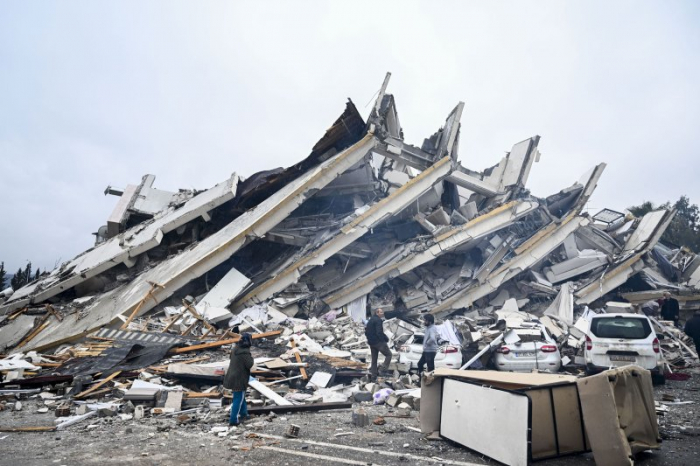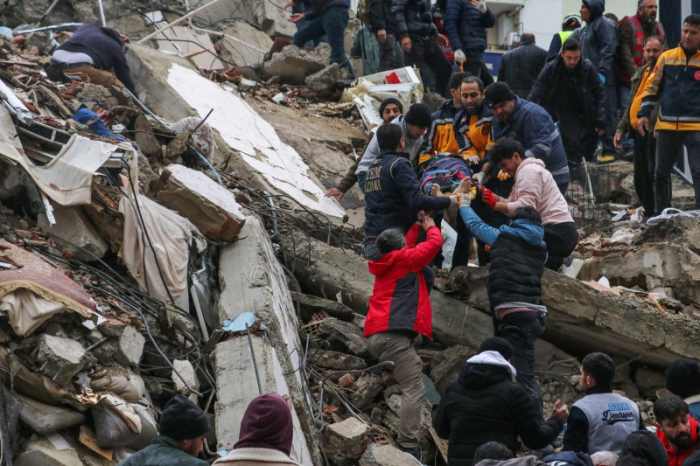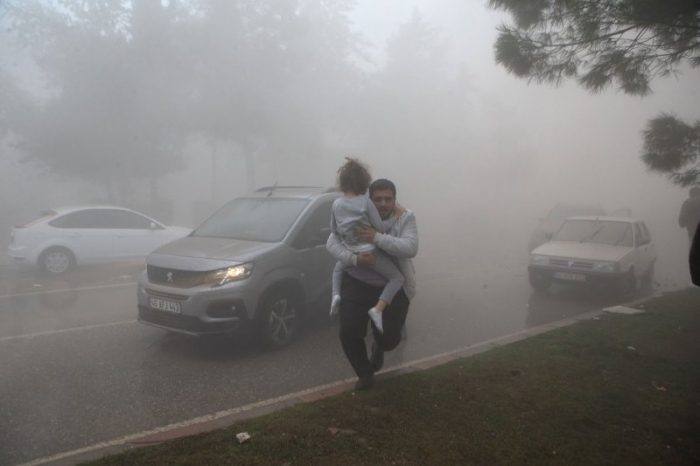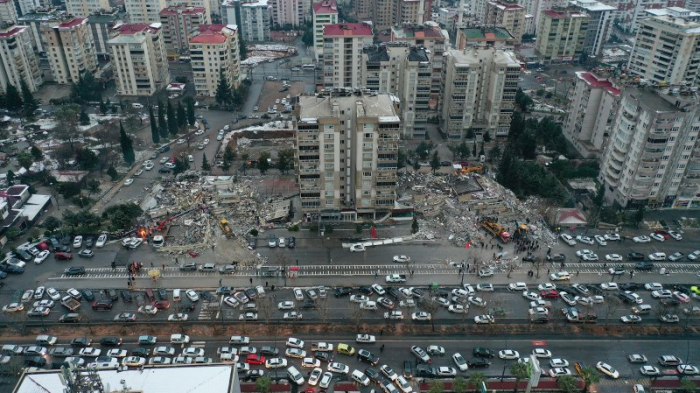When a 7.8 magnitude earthquake struck southeastern Turkey and northwestern Syria early Monday morning local time, its tremor could be felt as far afield as Lebanon, Cyprus, Greece, Israel, and the Palestinian territories. A second quake, which recorded a magnitude of 7.5, struck just 9 hours later.
Both countries are still reeling from the devastating aftermath. So far, at least 4,300 people have been killed as a result of the quakes, and thousands more have been injured. Thousands of buildings have been reduced to rubble.
Though earthquakes are not uncommon in this part of the world, today’s is believed to be the largest and deadliest one to hit Turkey in decades. Here’s what we know about it.
When and where did the earthquakes in Turkey occur?
The initial earthquake struck the southern Turkish city of Gaziantep, roughly 150 miles away from the Turkey-Syria border, at 4:17 a.m. local time at a depth of about 11 miles, according to the U.S. Geological Survey. The second earthquake, the epicenter of which was roughly 80 miles north of Gaziantep in Turkey’s Kahramanmaras province, struck at 1:24 p.m. local time and was six miles deep, according to USGS.
At least 120 aftershocks have taken place in southern Turkey, according to the country’s Disaster and Emergency Management Agency (AFAD).
How big is a 7.8 quake on the local magnitude scale?
While an earthquake magnitude of 2.5 or less can pass by undetected, earthquakes with a magnitude of 7.0 or higher are classified as a “major earthquake,” which can cause serious damage. A magnitude 8.0 or higher, considered “a great earthquake,” is capable of destroying entire communities.
While the magnitude of an earthquake denotes its size and strength, the potential damage caused by a quake is also determined by its depth (the shallower the quake, the more damaging) and its proximity to population centers.
In a tweet, U.S. Geological Survey seismologist Susan Hough likened the size of the initial earthquake in Turkey to San Francisco’s Great Earthquake of 1906, which left more than 3,000 dead and much of the city in ruin.

Are Turkey and Syria prone to earthquakes?
Earthquakes are not uncommon in Turkey. Most of the country is situated on the Anatolian Plate, which borders two major fault lines: the North Anatolian fault, which stretches across the country from west to east, and the East Anatolian fault, which is in eastern Turkey. The former has been the site of several disastrous earthquakes, according to the Geological Society of London, including the 1939 earthquake in northeastern Turkey that resulted in the deaths of 30,000 people.
Monday’s initial 7.8 magnitude earthquake is believed to have occurred on either the East Anatolian fault zone or the Dead Sea transform fault zone, according to USGS.
What is the scale of the damage?
The death toll has been staggering and has surpassed 4,300 people—figures that are almost certain to continue to rise amid search and rescue efforts. In Turkey, 2,921 deaths have been recorded so far, according to the state-run news agency Anadolu. In Syria, 711 deaths were recorded in government-controlled areas. Civilian rescue agencies have reported over 740 deaths in opposition-controlled areas.
While the full scale of the infrastructure damage is yet to be fully known, AFAD official Orhan Tatar said late Monday that more than 5,500 buildings collapsed. One airport runway serving the southern part of the country tore open.
Tatar also said over 6,400 people have been rescued from fallen structures so far.

What the earthquakes mean for Syrian refugees
The densely-populated northwestern region of Syria impacted by the earthquakes is already home to more than 4 million people who rely on humanitarian assistance, according to the U.N. Office for the Coordination of Humanitarian Affairs.
Many are internally displaced persons who have fled for opposition-controlled areas since the Syrian conflict broke out more than a decade ago. The region is controlled by various armed groups and relies heavily on international aid, most of which is delivered via Turkey.
The region had already been grappling with a cholera outbreak before the Monday’s earthquakes.
Warnings over building construction in Turkey
Turkey’s Union of Engineers and Architects (TMMOB) have long been sounding the alarm on the lack of earthquake infrastructure, given Turkey’s location on the Anatolian Plate means that damaging earthquakes are a matter of when, not if.
After a devastating earthquake hit the country in 1999 and killed some 17,000 people, the government at the time promised to reform the country’s earthquake infrastructure—pledging to create new construction standards and strengthen existing buildings. The plan involved designating hundreds of urban spaces as evacuation points in case of emergency. But, over the years, an explosion of new developments undid many of the planned earthquake readiness improvements, and open air evacuation zones were converted into high rises, NPR reported in 2017.

“This place you see in front of us was a public green space, and after the 1999 earthquake, it was designated as a public meeting area,” lawmaker Gursel Tekin told NPR at the time. “Unfortunately, now it is only a monstrous concrete mountain.”
In the aftermath of a 5.9 magnitude earthquake at the end of 2022, TMMOB released a statement saying that “our country has failed in terms of what needs to be done before the earthquake.”
The union added that site supervision “continues to be seen as a procedure on paper only,” noting that, “It is essential that the design, construction and inspection processes are carried out in a correct and vigorous way in order to ensure the safety of buildings against earthquakes. In each of these three pillars of safe construction, it is known that there are serious problems both legally and in practice.”
How the international community responded to the earthquakes
Erdoğan confirmed that in addition to NATO and the European Union, 45 countries have reached out to Ankara with offers of assistance, including the United States, Britain , Israel, and even war-torn Ukraine.
Russian President Vladimir Putin held separate calls with Erdoğan and Syrian President Bashar al-Assad to pledge assistance. Moscow is the most important foreign power operating in Syria.
Cyprus has also offered to send help to Turkey—a rare step from a country that Ankara has not recognized.

On Monday, U.S. Secretary of State Antony Blinken said, “Our initial assistance response to Türkiye is already underway, and U.S.-supported humanitarian organizations in Syria are responding to the earthquakes’ effects across the country. We are determined to do all that we can to help those affected by these earthquakes in the days, weeks, and months ahead.”
The E.U. will convene a crisis meeting Monday night to coordinate the bloc’s support measures. It is dispatching search-and-rescue teams and emergency mapping services.
How to donate and help victims of the earthquakes
International relief efforts are well underway. The International Federation of Red Cross and Red Crescent Societies has announced that it is launching “immediate cash assistance” from its Disaster Response Emergency Fund to help relief efforts. The Union of Medical Care and Relief Organisations, which provides healthcare in opposition-held parts of northwestern Syria, is also soliciting urgent international aid. Other charitable organizations such Oxfam, Action for Humanity, CARE, and Human Appeal have launched fundraisers to support their own teams working on the ground.















































